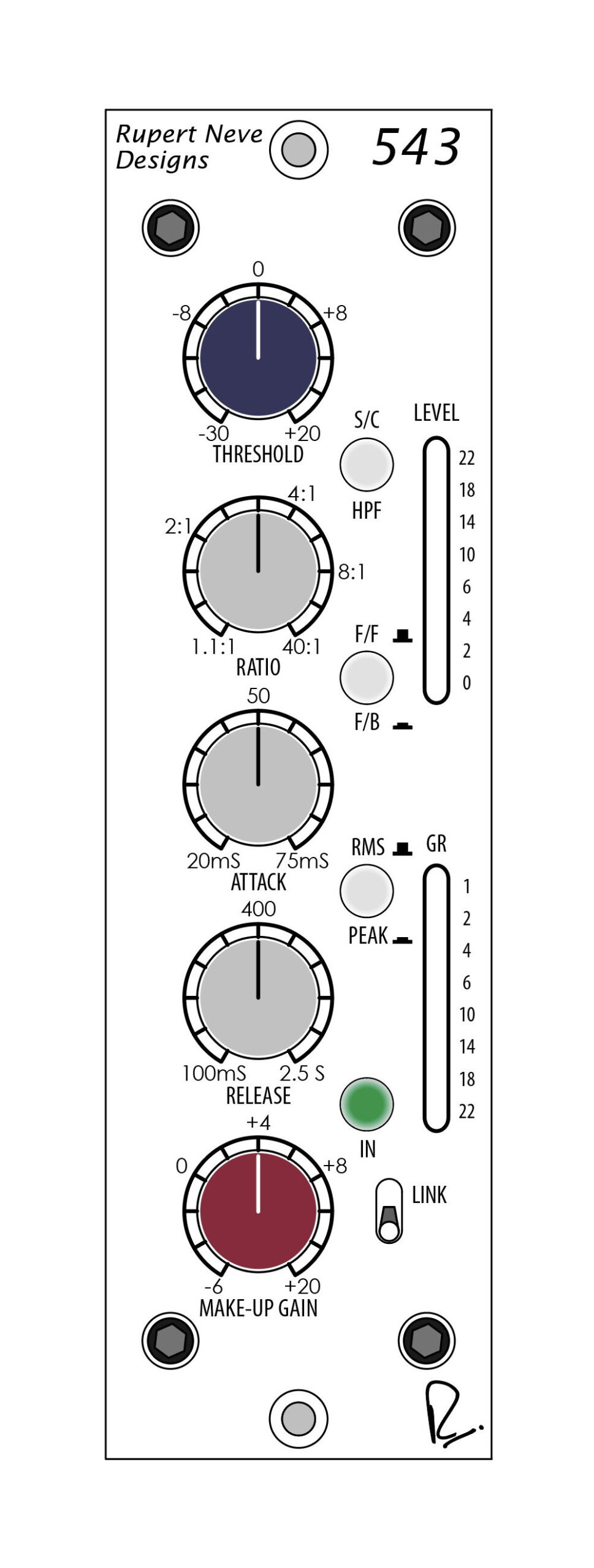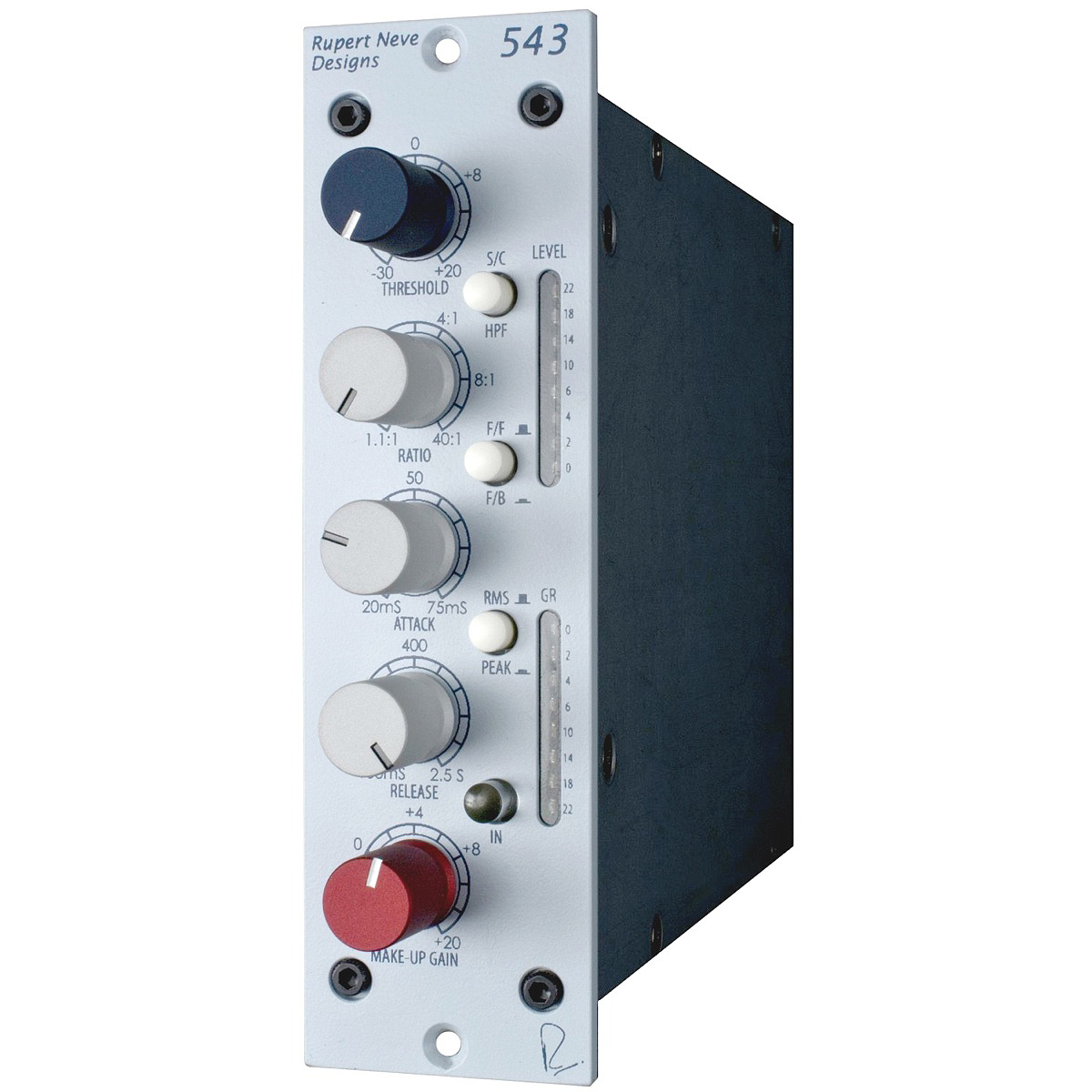Rupert Neve Designs 543 Compressor
$995.00
Whether you’re tracking, mixing or mastering, the 543 delivers unobtrusive, musical dynamic control and high-ratio limiting with massive flexibility, transparency and precision.
Please check with us about availability
Description
Rupert Neve Designs 543 Compressor
Clean, Precise, Powerful Level Control
Whether you’re tracking, mixing or mastering, the 543 delivers unobtrusive, musical dynamic control and high-ratio limiting with massive flexibility, transparency and precision.
The 543 features a fully controllable compressor-limiter with feed-forward / feedback modes, Peak / RMS detection and a built-in side chain high pass filter. With an unrivaled heritage and a tremendous feature set, the 543 provides an astonishing degree of flexibility and precision.
What is VCA Compression?
Every compressor has a gain control element in its circuit, and this is generally what determines the “sound” of the compressor. Some compressors use tubes, some use FETs, some use light-dependent resistors, some use a diode bridge – but in the 543, a VCA (Voltage Controlled Amplifier / Attenuator) is used to control the signal’s gain.
In contrast to a diode bridge design like our 535 compressor, which adds a thick, very colorful tonality to the source, the 543 makes use of a very accurate, low noise, low distortion VCA. This provides an immense amount of dynamic control and subtle warmth, without necessarily leaving a heavy sonic imprint on your tracks or mixes.
Feed-Forward or Feed-Back?

This switch changes the point in the signal path where the VCA control voltage is picked off: either before the VCA (feed-forward) or after the VCA (feed-back).
In most of Mr. Neve’s earliest designs, feed-back detection was intrinsic to the musical dynamic response. However, the very nature of a feedback compressor limits the attack time of the compression circuit, as the control voltage has already passed through the VCA itself. To offer faster, more technically accurate response times, feed-forward detection was also implemented in the 543: with the FF / FB switch, both classic and modern VCA responses are available.
RMS or Peak?

Another highly useful features of the 543 is the Peak / RMS mode, which allows the VCA to respond to both RMS (Root Mean Square) and peak levels. RMS circuits are considered to better mimic the way the ears perceive apparent loudness, while peak circuits tend to directly respond to the waveform voltage, which may be more of a concern for prevention of clipping and maximizing levels.
In the case of this particular circuit, peak mode actually uses a combination of both methods to get the best of both worlds, and avoids the drawbacks of each method on its own.
Features:

Threshold
Controls when the compressor begins to react from -30 dB to +20 dB. When set to +20 dB minimal to no compression is applied and more gain reduction as the knob is rotated towards -30 dB.
Ratio
Controls the “slope” of the compression from 1.1:1 (minimal) to 40:1 (Limit). In general, low ratio settings apply more subtle compression while high ratio settings can be more effective at preventing unwanted clipping.
Comp in
Illuminated push-button switch that engages the compressor.
F/F + F/B
Push-button switch that toggles between two different compressor modes, FEED FORWARD and FEED BACK. The F/B mode (button in) tends to sound smoother and more natural. The F/F mode can be more useful for shaping the envelope of the sound and introducing more ‘pumping’, if desired.
Make-Up Gain
Continuously variable control for the make-up gain of the compressor within a range of -6 dB to +20 dB.
Attack
Controls how quickly the compressor reacts and starts attenuating. Continuously variable within a range of 20mS to 75mS.
Release
Controls how quickly the compressor stops applying gain reduction. Continuously variable within a range of 100mS to 2.5 Seconds.
RMS/Peak
Push-button switch that toggles between the compressor responding to the RMS level of the audio or responding to the PEAK level. RMS (root mean squared) more accurately mimics the way the ears perceive apparent loudness, while PEAK directly responds to the waveform voltage, which may be more useful to prevent clipping and maximize levels.
S/C HPF
Push-button switch that engages the high pass filter (fixed at 250Hz) for the side chain of the compressor. Please note that the high pass filter is not applied to the main audio output, this only adjusts the frequency range of the signal being compressed..
Link
Switch that engages the stereo compressor link mode, linking the gain reduction circuits to work in tandem.
To learn more about Rupert Neve, Click Here
View more products from Rupert Neve Designs
Additional information
| Weight | 5 lbs |
|---|---|
| Brand | Rupert Neve |
| Condition | New |
Technical Specifications
Gain Range:
Continuously variable from 6 dB to +20 dB.Threshold Range:
Continuously variable from 36 dB to +22 dB.Ratio Range:
Continuously variable from 1.1:1 to Limit (40:1).Attack Range:
Continuously variable from 20mS to 75mSRelease Range:
Continuously variable from 100mS to 2.5 Seconds.FF/FB:
Feed-Forward or Feed-Back VCA control.Maximum Output Level:
- Balanced and Floating Transformer Output
- Maximum output from 20 Hz to 40 kHz is +23 dBu.
Total Harmonic Distortion and Noise:
- @ 1kHz, +20 dBu output level, no load.
- Main Output, compressor bypassed
- Better than 0.0006%.
- Main Output, compressor engaged
- Better than 0.02%
Noise:
- Measured at Main Output, un-weighted, 22Hz-22kHz, Terminated 40 Ohms.
- With Gain at Unity, Compressor disengaged
- Better than 103 dBu.
- With Gain at Unity, Compressor engaged:
- Better than 92 dBu
Frequency Response:
- Main Output, Unity Gain
- @ 18 Hz, +/- .1dB
- @ 150 kHz -3 dB.
Crosstalk
- Measured Channel to Channel:
- Better than 90 dB @ 15kHz.






